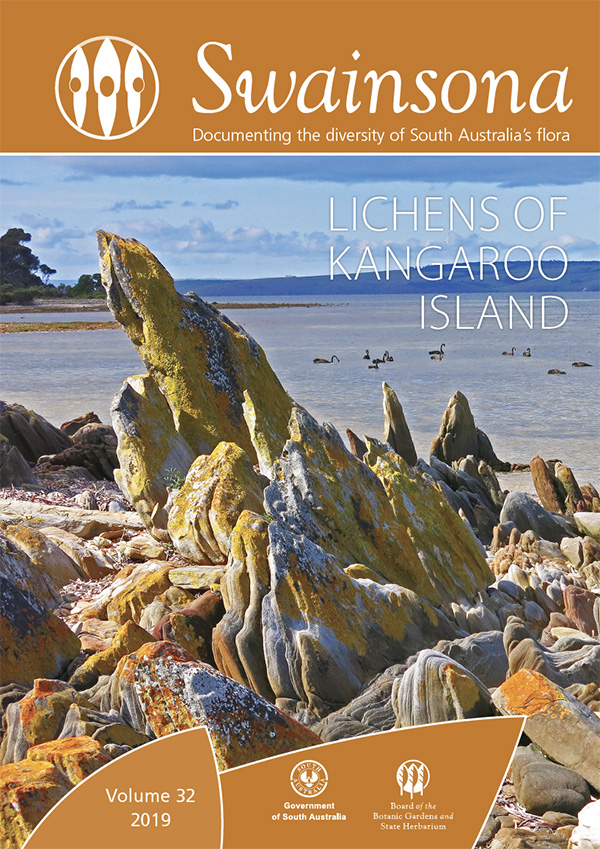Now available!
Catcheside, P.S. & Catcheside D.E.A. (2024). The fungi of Kangaroo Island – and beyond: An illustrated field guide to the larger fungi of Southern Australia. (State Herbarium of South Australia: Adelaide).

This long-awaited guide to the fungi of southern Australia has a focus on iconic Kangaroo Island. On the wetter west end of the island the authors encountered a rich assemblage of fungi, many of which are also found on the mainland. The book is the culmination of decades of research and fieldwork on the fungi of Kangaroo Island, South Australia and Australia.
The book provides 450 photographs illustrating 260 species of fungi, detailed, full-page descriptions of 206 species, a guide to the diversity of fungi, how to collect the larger species, tips on photographing them, a bibliography, an account of the effects of fire on fungi and of the joys and occasional frustrations of fungal forays in South Australia, the driest state in this driest continent.
Retail price: $75.00
Wholesale price on request, please contact the Editor, Jürgen Kellermann (juergen.kellermann@sa.gov.au), or the State Herbarium (stateherbsa@sa.gov.au).
You will be able to purchase the book in person from the Botanic Gardens reception desk (Goodman Building, Hackney Road, Adelaide) and online through the Openbook Howden web-shop (postage is extra):
https://openbookhowden.com.au/bookstore/product/the-fungi-of-kangaroo-island-and-beyond/
About the authors
Pam Catcheside has been working on the fungi of South Australia for 25 years and has extensive knowledge of the taxonomy, ecology and conservation of the larger fungi. She is an Honorary Research Associate at the State Herbarium of South Australia, Adjunct Lecturer at Flinders University and founder of the Adelaide Fungal Studies Group.
David Catcheside was formerly Head of The School of Biological Sciences at Flinders University and is now an Emeritus Professor. He has been involved in research for more than fifty years, primarily as a microbial geneticist, but more recently in forensic science and aspects of mycology triggered by Pam’s interests in the larger fungi.

Key Features
- Introduction to the kingdom of the fungi – what they are, their position in the biota
- Classification of fungi: Basidiomycetes, Ascomycetes, Zygomycetes; also lichens and slime moulds
- Numbers of fungi
- Variety of fungal forms, e.g. gilled fungi, boletes, brackets, corals and clubs, jellies, puffballs, crusts, disc and cup fungi, morels, flasks, truffles
- Ecology of fungi: habitats, trophic modes
- Importance of fungi, their roles in the environment
- Uses of fungi, their economic importance
- 201 species of fungi covering a wide variety of forms, with one page per species
- Each species covered by photograph; macroscopic features e.g. cap, gills, stems (for gilled fungi); habit; habitat; where to find it; notes of interest
- Each species with scientific and common names, derivation of scientific name, genus/family
- Written in an accessible style for both professional mycologists and interested naturalists
- 380 pages, flexibound with vinyl outer cover (to withstand the weather).
The book can also be purchased at the following bookshops and retail-outlets:
- North Lodge, Adelaide Botanic Gardens
- Matilda Bookshop, Stirling
- State Flora, Belair National Park
- Big Quince, Kingscote (Kangaroo Island)
Other mycological publications
Kantvilas, G. (2019). Lichens of Kangaroo Island. Swainsona special volume 32.
Hobart-based lichenologist Gintaras Kantvilas, Head of the Tasmanian Herbarium, presents the results of over 10 years of work on the lichens of Kangaroo Island. During this time, the author undertook extensive fieldwork and reviewed more than 1500 herbarium specimens. The lichen flora of Kangaroo Island consists of 366 taxa, of which 14 are restricted to the island. Ninety-five species are reported for South Australia for the first time, of which 19 are also new records for Australia.
It is the first study to thoroughly examine and document the lichens of the Kangaroo Island. Each species is listed with a short, diagnostic description, many are illustrated with colour photographs. All specimens used to compile the catalogue of lichens are listed, making this publication an invaluable tool for future research. A brief history of lichenological work on the island is included, as well as a description of the habitats that lichens occur in.
This landmark study was published just before the devastating 2019/20 bushfires and gives an insight into the lichen flora of the island, prior to its destruction.
A4, 108 pp., soft cover.
Retail price: $42.00
Available in person at the Botanic Gardens reception desk (Goodman Building, Hackney Road, Adelaide) or email the State Herbarium for mail orders (stateherbsa@sa.gov.au).
The volume contains two articles, which are also available online:
- An annotated catalogue of the lichens of Kangaroo Island, South Australia. Swainsona 32: 1-97. (27.9mb PDF).
-
South Australian lichens — A Kangaroo Island case study. Reprinted from Swainsona 30: 17-24. (3.3mb PDF).




